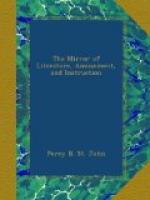In the early part of the last century, Somerset House was occasionally appropriated to masquerades and other court entertainments. In the reign of George II. William, Prince of Orange, resided here a short time; and in 1764, the hereditary Prince of Brunswick became an inmate, prior to his nuptials with the Princess Augusta, sister to George III. In April, 1763, a splendid fete was given here to the Venetian ambassadors, who were entertained several days in this mansion.
In the year 1761, the second of his late majesty, Somerset House was settled on the queen consort, in the event of her surviving the king; but in April, 1775, in consequence of a royal message to Parliament, it was resolved, that “Buckingham House, now called the Queen’s House,” should be settled on her majesty in lieu of the former, which was to be vested in the king, his heirs and successors, “for the purpose of erecting and establishing certain public offices.” An act was consequently passed in the same year, and shortly afterwards the building of the present stately pile was commenced under the superintendence of the late Sir William Chambers. Extensive, however, as the buildings are, the original plan has never been fully executed, and the eastern side is altogether unfinished. The splendour of the building is, however, shortly to be completed by the erection of another wing, to be appropriated as the King’s College; and surveys have already been made for this purpose.
The print represents the original mansion, or, we should rather say, city of mansions, with its monastic chapel, and geometrical gardens, laid out in the trim style of our forefathers. The suite of state apartments in the principal front was very splendid, and previously to their being dismantled by Sir William Chambers, they exhibited a sorry scene of royal finery and attic taste. Mouldering walls and decayed furniture, broken casements, falling roofs, and long ranges of uninhabited and uninhabitable apartments, winding stairs, dark galleries, and long arcades—all combined to present to the mind in strong, though gloomy colours, a correct picture of the transitory nature of sublunary splendour.
In the distance of the print is the celebrated Strand maypole, although its situation there does not coincide with that marked out in more recent prints. The original of our Engraving is a scarce print, by Hollar, who died in 1677.
In the year 1650, an act was passed for the sale of the “honours, manors, and lands heretofore belonging to the late king, queen, and prince,” for the payment of the army; and under that act were sold several tenements, &c. “belonging unto Somerset House.” In this list were several signs, and it is remarkable, that the Red Lion, (opposite the Office of the Mirror, and at the corner of Catherine-street, in the Strand) is the only one which now remains. The Lion may still be seen on the front of the house. The Red Lion wine vaults, three doors from this corner was probably named from the above, since nearly every house formerly had its sign.




